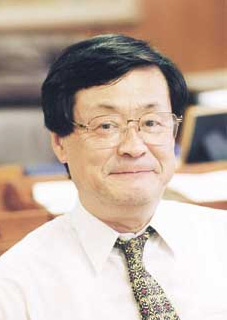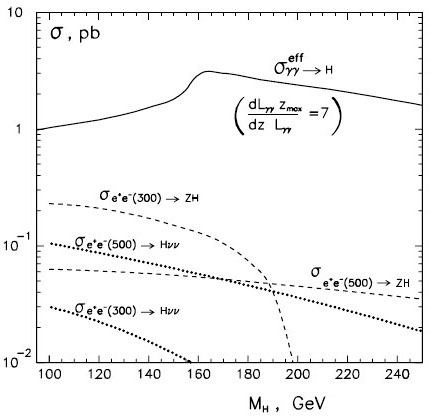Director's Corner
11 December 2008
 Barry Barish |
A low-energy gamma-gamma collider as a first step toward the ILC?
The International Linear Collider Steering Committee (ILCSC) met immediately after last month's International Committee on Future Accelerators (ICFA) Seminar on future prospects for particle physics. The spirit of new ideas that prevailed at the ICFA meeting continued into the ILCSC meeting where Hirotaka Sugawara, former director general of KEK, Japan, presented a different approach towards the ILC. He suggested building a lower-energy gamma-gamma (γγ) machine as a first step towards the ILC. The ILCSC is now evaluating the pros and cons of this idea. They have asked both Research Director Sakue Yamada and me to do some homework to aid them in evaluating this suggestion.
Specifically, the ILCSC agreed "to continue this discussion at the next ILCSC meeting; meanwhile, the GDE's Accelerator Advisory Panel should look at the technical implications and impact on GDE, and a small group from the RD's Physics Panel should look at the physics aspects."
Inclusion of a gamma-gamma option in the ILC design has been part of the mandate for the GDE from the beginning of our work. An ILCSC subpanel laid out the parameters and options that are guiding our design in a document titled "Parameters for the Linear Collider." This report states about the gamma-gamma option: "Several physics measurements are uniquely enabled through collisions of (polarized) photons, or electrons and photons, from backscattered laser beams. High polarization of both electron beams is required. This option will require transformation of one interaction region to run as a γγ (gamma-gamma) or eγ (electron-gamma) collider at any energy up to 80% of the e+e- maximum energy, with reduced luminosity (some 30-50%) with respect to the e+e- (electron-positron) luminosity. It is desired to keep the option of providing a second beam delivery system without major interruption. More studies on the technical aspects of a γγ or eγ collider are required by the experimental community."
The gamma-gamma option requires using an interaction region with a larger crossing angle (> 20 milliradians) than that in our RDR baseline (14 milliradians), in order to avoid disruption of the primary electron beam that will result from the laser-beam interactions. For that reason, we deferred studies of gamma-gamma during the reference design stage where we only considered the ILC baseline. Special studies of gamma-gamma and others options (like future extension to energy of 1 Tera-electronvolt) are planned as part of our work during the technical design phase.
So, what is new or different in Sugawara's proposal? In brief, he anticipates the discovery of a low-mass Higgs from the early physics from LHC, and then argues that a lower-energy gamma-gamma machine where the Higgs cross sections are large will be able to quickly capitalise on this discovery, while at the same time being a less expensive first step towards an ILC.
The cruxes of his arguments (in his words) are that "almost all the theoretical or phenomenological studies indicate that Higgs boson is less than 170 GeV. The cross section for single Higgs production at the resonance point by photon-photon collision is of the order of 100 micro-barn, roughly 10,000 times larger than the corresponding e+e- collision case. The luminosity of the photon-photon collider can be made at least one tenth of that of the driving electron-electron collider by locating the point of Compton scattering points to be about 1mm away from the collision point of photon-photon collider. The peak laser power needed for this is about 1 terawatt ..."
A series of other questions need to be addressed. For example, even assuming a low mass Higgs is discovered, how compelling will the science case be for building a first step gamma-gamma Higg's factory machine, as a prelude to the ILC? How ready is the technology at this time to make such a machine? In particular, is the high-power laser technology that will match the characteristics of a superconducting linac available to yield the high luminosity - or will significant future R&D be required? How much cost saving can be expected for this initial step relative to the cost of the full scope ILC and will it lend itself to a direct upgrade to an ILC? How much additional cost will be incurred in first building a low-energy gamma-gamma machine and then converting it to make the upgrades to the full scope of the ILC? How much schedule delay can be anticipated in this step-by-step approach before building the full-scope ILC? There are other practical questions, such as how many resources would be required to undertake more detailed studies of gamma-gamma and who would perform them.
New ideas and strategies as toward our goal of developing a complementary lepton (and photon) collider option for the LHC are both welcome and encouraged. On the other hand, we need to remain well focused on our goals to produce a robust and well worked-out technical design and project implementation plan for the ILC to present to our governments on the timescale of the next few years. Input from the community and guidance from ILCSC as we develop strategy and proceed with our work are vital to our success and we encourage them.
The GDE is presently doing some preliminary analysis of technical feasibility and costs as requested by the ILCSC through our internal GDE Accelerator Advisory Panel (AAP), chaired by Bill Willis and Eckhard Elsen. Similarly, Sakue has asked a subgroup led by Michael Peskin (SLAC) to study the prospects and implications from the point of view of the physics and detectors. These two groups have met and are in communication with each other. Our plan is to produce a unified report for the ILCSC that has been reviewed by our GDE Executive Committee on the timescale of the ILCSC February meeting.
-- Barry Barish


